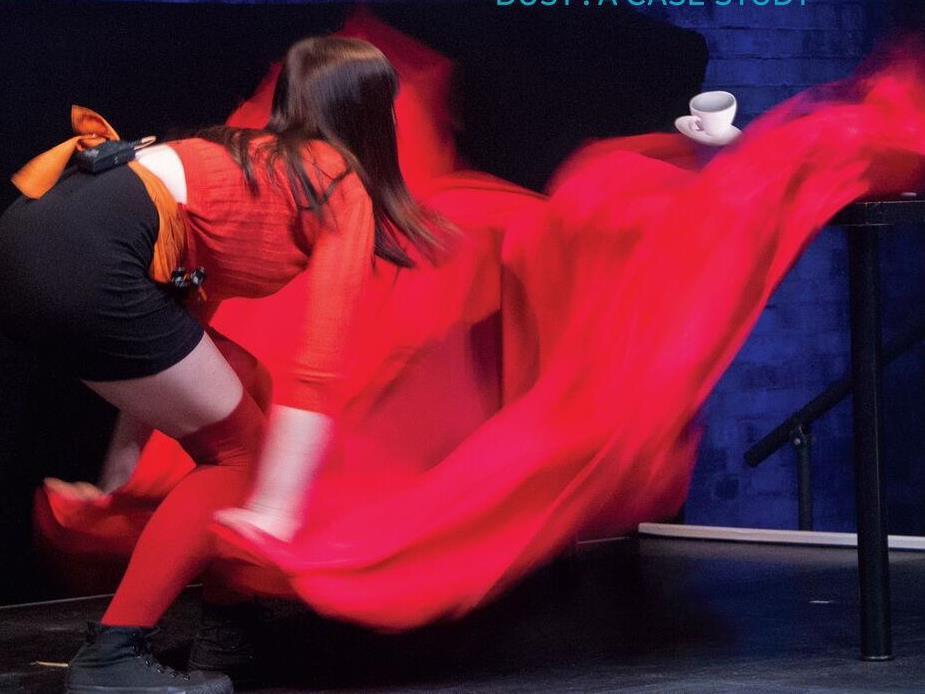Image from Dust, Photo: Lindy Allen
When creating political theatre, I focus on the experience of the audience going to the theatre rather than the issue. If you are instinctively a political person, as I am, the pull of the issue you want to make the world understand is seductive. But I have learned that I can communicate this more effectively by making stimulating theatre and events. I’ve had to hone my craft to be able to make something as a writer and director that will give people something they can’t get in a screen or online experience.
Ron, my favourite bricklayer, invited me to the 2006 Asbestos Memorial Service, which is held once a year in November in the Edge theatre at Federation Square, alongside the Yarra River in the centre of Melbourne. I went to the service with my friend, composer and songwriter Mark Seymour. He had written the music and performed in We Built This City and accompanied me to see if the issue of asbestos was something that could be developed into a project structured along similar lines.
The service, led by Bishop Phillip Huggins, was non-denominational and very moving. As a theatre person I admired the skill with which Bishop Huggins acted as the leader and compère for the service. I appreciated the manner in which he led the audience/congregation to be present in the room by inviting people to introduce themselves and shake hands with others seated nearby, which created a personal connection. He used the hour to lead us into a place of sorrow and contemplation where the deaths from exposure to asbestos were acknowledged. He also led a section where people could light a candle or place a flower in a pool of water to remember a family member who had died. Huggins then brought the audience into the present by asking them to join with him to give thanks to all the people who were working to fight this issue. With this there was a feeling of hope and of working for change as a group on this issue rather than being paralysed by grief. This was a memorial service and also a fine piece of theatre that led the audience through the dark into a place of strength.
He was sick with asbestosis but he was making a strong point and making us laugh…I thought, “This is it. This is how to make a show a about a hard topic like asbestos”.
After the service Ron said his union, the CFMEU, would be hosting a free BBQ on the Yarra River and he would be cooking. I walked outside to the riverbank and ate a barbequed sausage on white bread with sauce, provided for everyone, unionists and non-unionists alike Ron had on an apron and was carrying a pair of BBQ tongs. He told a story about working as a bricklayer using refractory bricks to build a crematorium. He said that this “crem” he built was one of the best in Australia, if not the southern hemisphere. It was fantastic.
What I haven’t told you is that Ron has asbestosis and he wheezes when he speaks. Ron was very proud of his work, so much so that, when he died, he wanted to be cremated in this crematorium and have the lid off his coffin so he could admire his brickwork as he burnt. Other evocative parts of this story were some facts about how fast this “crem” could burn a body without creating any smell. It was a funny, dark and true story. It was punctuated by the sound of Ron’s wheezes.
Here was a man who had been exposed to asbestos through work by laying firebricks (the crematorium furnace had an asbestos lining), and he was sick with asbestosis but he was making a strong point and making us laugh. As we stood in the sun I thought, “This is it. This is how to make a show a about a hard topic like asbestos”. I could use true stories conveyed with this kind of humour and strength and go hard about death and injustice at the same time. Asbestosis is shocking and sad but watching Ron and listening to him as an audience, I was entertained and surprised.
Ron had given me the idea about how to make a theatre work on asbestos. This process of making theatre has had several names and is often referred to as verbatim theatre. Anderson and Wilkinson have described the purpose of this style of theatre as “to reveal truths in a simple and accessible way through authentic personal narratives”. I had found the means and style of creating the theatre work Dust. I knew now that I could do the show.
Dust was created seven times with seven communities between 2008 and 2013. A study of audiences found 100% had subsequently shared safety messages with family and friends.
This article is an excerpt from Art and Social Change – Dust a Case Study by Donna Jackson. The book will be launched on Sunday 19 June 2016 at Williamstown Literary Festival Hub. The book can be purchased from www.paperbackbooks.com.au.





